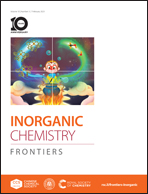Hydrogen production via the aqueous-phase reforming of methanol catalyzed by Ru(ii) complexes of PNNP ligands†
Abstract
Hydrogen (H2) production by the aqueous-phase reforming of liquid organic hydrogen carriers such as methanol, ethanol, and formic acid has attracted much interest recently as it offers a safe and convenient means of producing H2 on demand by mitigating the costs and safety challenges associated with the storage and transportation of H2. Using efficient catalysts operative under easily achievable conditions is the key to the success of such reactions. Herein four Ru(II) complexes with PNNP ligands, namely [Ru(Ph2PPhCH![[double bond, length as m-dash]](https://www.rsc.org/images/entities/char_e001.gif) N(1,2-cyclohexylene)N
N(1,2-cyclohexylene)N![[double bond, length as m-dash]](https://www.rsc.org/images/entities/char_e001.gif) CHPhPPh2)Cl2] (1), [Ru(Ph2PPhCH
CHPhPPh2)Cl2] (1), [Ru(Ph2PPhCH![[double bond, length as m-dash]](https://www.rsc.org/images/entities/char_e001.gif) NCH2CH2N
NCH2CH2N![[double bond, length as m-dash]](https://www.rsc.org/images/entities/char_e001.gif) CHPhPPh2)Cl2] (2), [Ru(Ph2PPhCH2NHCH2CH2N
CHPhPPh2)Cl2] (2), [Ru(Ph2PPhCH2NHCH2CH2N![[double bond, length as m-dash]](https://www.rsc.org/images/entities/char_e001.gif) CHPhPPh2)Cl2] (3), and [Ru(Ph2PPhCH2NHCH2CH2NHCH2PhPPh2)Cl2] (4) were synthesized and evaluated for catalyzing the aqueous-phase reforming of methanol (APRM). Comparative studies between better performing 2 (than 1) and its closely related analogs 3 and 4 revealed the profound influence of the ligands on their catalytic activities with the best-performing 2 producing a maximum TON of 12 639 after 8 days. Mechanistic studies using in situ1H NMR and high-resolution electrospray ionization mass spectrometry (HRESI-MS) suggested the presence of two key intermediates, formulated as [Ru(Ph2PPhCH
CHPhPPh2)Cl2] (3), and [Ru(Ph2PPhCH2NHCH2CH2NHCH2PhPPh2)Cl2] (4) were synthesized and evaluated for catalyzing the aqueous-phase reforming of methanol (APRM). Comparative studies between better performing 2 (than 1) and its closely related analogs 3 and 4 revealed the profound influence of the ligands on their catalytic activities with the best-performing 2 producing a maximum TON of 12 639 after 8 days. Mechanistic studies using in situ1H NMR and high-resolution electrospray ionization mass spectrometry (HRESI-MS) suggested the presence of two key intermediates, formulated as [Ru(Ph2PPhCH![[double bond, length as m-dash]](https://www.rsc.org/images/entities/char_e001.gif) N-CH2CH2-N-CH2PhPPh2)(H)] (I1) and [Ru(Ph2PPhCH2-NH-CH2CH2-N-CH2PhPPh2)(H)] (I2) bearing respectively the half and fully reduced PNNP ligands. Comparative studies revealed that I1 is more active than I2. A mechanism involving the association and activation of the substrate (i.e. CH3OH, HOCH2OH, and HCOOH) mediated by the cooperative Ru–N− set-up, followed by the stage-wise release of H2, is proposed.
N-CH2CH2-N-CH2PhPPh2)(H)] (I1) and [Ru(Ph2PPhCH2-NH-CH2CH2-N-CH2PhPPh2)(H)] (I2) bearing respectively the half and fully reduced PNNP ligands. Comparative studies revealed that I1 is more active than I2. A mechanism involving the association and activation of the substrate (i.e. CH3OH, HOCH2OH, and HCOOH) mediated by the cooperative Ru–N− set-up, followed by the stage-wise release of H2, is proposed.



 Please wait while we load your content...
Please wait while we load your content...